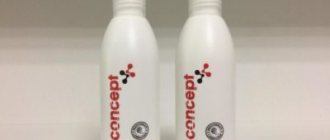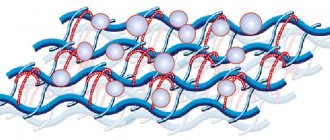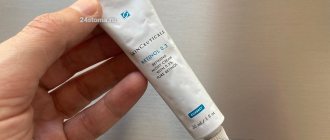From this article you will learn:
- Fermenkol: patient reviews, price,
- Fermenkol gel - instructions for use using the application method and using the phonophoresis technique.
Fermenkol is a drug based on a complex of proteolytic enzymes (collagenolytic proteases) obtained from marine and freshwater organisms. Fermenkol destroys excessively formed pathological collagen, which makes up hypertrophic and keloid scars.
Indications for use –
- for hypertrophic and keloid scars (Fig. 1-2),
- for scars after acne (Fig. 3),
- to prevent the occurrence of these types of scars.
Basic information
The drug is used to eliminate the effects on the skin after surgery, burns, wounds, acne. Used to solve problems with limited movements in joints. Active ingredients selectively affect scar tissue, causing the destruction of elastin, collagen, and hyaluronic acid in them.
The medication shows sufficient effectiveness:
- for fresh and old keloid, hypertrophic scars;
- renewal of the skin – results reach 90%;
- leveling the relief of the dermis, increasing its elasticity, normalizing tone.
It is used in most aesthetic medicine clinics; at home, it can save up to 25 thousand rubles.
The product has proven safety:
- it contains no hormonal substances and contains natural preservatives and elements;
- Can be used for newborn babies, pregnant or lactating women.
The medicine does not create additional trauma to the skin, which happens with laser manipulation. Local action on problem areas does not affect nearby healthy tissue.
Introduction
The mechanism of administration of medicinal substances during therapeutic electrophoresis is electrogenic, i.e., their movement in an electric field and introduction into the integument of the body must occur along an electrical potential gradient. Electrogenic administration increases the delivery of medicinal and biologically active substances to the area of the pathological focus (including the scar) by 1-2 orders of magnitude compared to passive diffusion. It should be emphasized that in relation to the drug Fermencol, the electrogenic mechanism of introduction into the body has until now been hypothetical. Laboratory studies confirming the movement of the components of Fermenkol® in an electric field have not been carried out. No clinical studies have been performed.
There is a well-known empirical practice of combining the use of a solution of Fermencol powder in the Solactin preparation with the influence of a constant continuous electric current. Until now, this technique has been commonly called Fermenkol therapeutic electrophoresis. In this case, the drug Fermenkol is applied to the subelectrode pad of the electrode connected to the therapeutic connector of the galvanization apparatus, and the electrical voltage is turned on. This simulates the procedure of therapeutic electrophoresis.
Long-term follow-up observations indicate that the results of treatment of skin scars improve when exposed to the drug Fermenkol in combination with constant continuous current. These observations can be explained a priori by the fact that physical exposure to direct current (galvanization) always increases the permeability of the skin barrier to substances of exogenous origin, increases the intensity of simple diffusion of substances, including polypeptides through the epithelial integument. Increased diffusion of substances through the integument of the body when exposed to galvanic current should not be equated with the electrogenic transfer of substances, i.e., with therapeutic electrophoresis
The purpose of the study was to substantiate the possibility of introducing the drug Fermenkol into the human body using direct current and to develop a method of therapeutic electrophoresis of the drug.
To achieve this goal, it was necessary to solve the following tasks:
- Substantiation of the possibility of introducing polypeptides from a solution of the drug freeze-dried Fermencol powder into the human body using direct currents.
- Justification of the possibility of introducing polypeptides from the drug Fermenkol gel into the human body using direct currents.
- Development of a method for therapeutic electrophoresis by galvanic current of polypeptides from a solution of the drug, freeze-dried powder Fermenkol.
- Development of a method for therapeutic electrophoresis with diadynamic current of polypeptides from a solution of the drug, freeze-dried Fermencol powder.
- Development of a method for therapeutic electrophoresis from the drug Fermenkol gel.
- Development of a method for therapeutic electrophoresis with diadynamic current from the Fermenkol gel preparation.
Therapeutic electrophoresis is only possible for substances that are soluble in electrically conductive media (water, alcohol mixed with water). Of the three medicinal forms of the drug Fermenkol®, these include a solution of freeze-dried powder in the drug Solactin and Fermenkol gel.
We have scientifically substantiated the possibility of therapeutic electrophoresis of two therapeutic forms of the drug Fermenkol:
- freeze-dried Fermenkol powder dissolved in the Solactin preparation;
- Fermenkol gel.
The result was the development of practical methods of therapeutic electrophoresis.
To achieve this goal, it was necessary to solve the following tasks:
Determine the electrical conductivity of medicinal forms of the drug Fermencol:
- a solution of the drug Fermenkol in Solactin solvent;
- Fermenkol in the form of a gel
To evaluate the mobility of polypeptides of the drug Fermenkol in the electric field in the form of a solution of freeze-dried Fermenkol® powder in Solactin solvent based on the indicator of electrogenic mass transfer of polypeptides.
Determine the conditional “isoelectric point” of the Fermencol® solution based on the minimum mass transfer of polypeptides.
Select the optimal pH value of the solvent, ensuring maximum mass transfer of the drug.
Assess the mobility of polypeptides of the drug Fermenkol® in the form of a gel in an electric field based on the indicator of electrogenic mass transfer of polypeptides.
Determine the conditional “isoelectric point” of the Fermenkol® gel based on the minimum mass transfer of polypeptides.
Select the optimal pH value of the solvent, ensuring maximum mass transfer of the drug.
You can purchase all Fermenkol products in our online store
Order online
What is it used for?
In therapeutic practice, the product is used to correct scars:
- in surgical practice – after operations or at risk of their formation;
- traumatological, orthopedic – with incomplete ability to bend/extend joints in the limbs and fingers;
- gynecological – traces after highly targeted surgical interventions, including episiotomy;
- urological – when scarring affects the external genitalia, bladder, ureters, urethral canal;
- otorhinolaryngological – for hearing loss associated with the specified problem;
- combustiological – consequences of burn disease.
Therapeutic procedures help reduce the effects of acne, filler installations, etc.
The only prohibition on their implementation is individual intolerance to the component components of the medications.
Summary
We studied the mobility of the drug Fermencol in an electric field. Fermenkol is a complex polypeptide preparation obtained from the tissues of aquatic organisms. Contains a complex of 9 collagen lytic proteases with a molecular weight of polypeptide components from 20 to 100 kDa. Possessing high collagenolytic activity, Fermenkol is used in medical practice for the treatment (correction) of hypertrophic and keloid scars. The rationale for the therapeutic method of electrophoresis of the drug Fermenkol is given, and the optimal parameters are worked out.
How to use
The drug is used in electrophoresis, a common physiotherapeutic technique. The introduction of medications takes place using an electric current passing through the mucous membranes or skin. The method is considered safe and well tolerated by patients of all age groups.
The concentration of Fermenkol solution is selected according to the underlying pathology, the age of the patient, and the characteristics of the scars: according to the area and depth of changes. For medical manipulations, take from 0.1 to 0.2 ml of the drug per square centimeter of the affected area:
- a layer based on a gauze napkin (filtered paper) is wetted with the composition;
- applied to dry, pre-cleaned dermis;
- an electrode is installed on top, covered with a gasket soaked in water - it protrudes beyond its boundaries, helping to avoid accidental burns;
- the introduction begins with a positive anode with a current density of up to 0.1 mA per cm2 - if the changes are on the skin of the limbs or body and up to 0.5 mA per cm2 when treating the neck and face;
- treatment procedures last up to 25 minutes and take place every day;
- an interval between manipulations of 48 hours is allowed;
- the course lasts up to 15 procedures in a row;
- If repeated therapy is necessary, a break of one calendar week is observed.
If treatment is required for children under five years of age, then electrophoresis on the face and neck is performed with a current of up to 0.01 mA per cm2. Manipulations are performed for about 15 minutes.
Fermenkol gel from the En Ther cosmetic line for application and phonophoresis
| Fermenkol gel, 30 g, transparent mass in a tube. One gram of gel contains 0.1 mg (0.01%) of the active substance - a complex of collagenolytic proteases; excipients: water, glycerin, glyceryl polyacrylate, diazolinidyl urea, methylparaben, propylparaben, propylene glycol. It is recommended to use for the care of problematic and scarred skin after operations, wounds, burns, purulent-inflammatory skin diseases, incl. acne (acne). |
Contraindications
Individual intolerance to collagenases, hypotrophic and atrophic scars.
Methods of application
Applique. Before using the gel, you must clean the skin area using a suitable skin cleanser. Apply Fermenkol gel with light movements, do not rub. Frequency of procedures: 2-3 times a day. Course duration is 30-40 days. The interval between courses is 10-14 days.
Phonophoresis in a cosmetology or physiotherapy room. The use of phonophoresis allows the delivery of collagenolytic enzymes to deep areas of scarred skin. Before the procedure, it is necessary to clean the skin area using a suitable cosmetic product to cleanse the skin. Apply a thin layer of Fermencol gel. Administration mode: energy flux density of no more than 300 mW/cm² when used in the torso and limbs and no more than 200 mW/cm² when used in the face.
The duration of the procedure is 3-5 minutes per area. After the phonophoresis procedure, you should remain indoors for about 30 minutes. Course duration is 10-12 procedures. Frequency of procedures: preferably daily at the same time of day. The interval between courses is 10-14 days.
| Remove Fermenkol gel from the package. Read the instructions carefully. | Clean the skin area. | Open the tube with the gel. |
| Apply the gel with light movements to the surface of the scar. | Carry out the phonophoresis procedure. | |
| Store in a cool, dry, dark place, do not freeze or heat above 40°C. |
Mechanism of scar reduction
Fermencol has high collagenolytic activity, providing deep hydrolysis of collagen peptide bonds. Hydrolysis of collagen occurs down to individual amino acids.
Fermenkol exhibits selective activity against branched molecules of pathological collagen with nodular and vortex folding, characteristic of keloid and hypertrophic scars, and is less active against fibrils of native collagen inherent in healthy connective tissue. Scar reduction occurs due to the destruction of excess collagen. In addition to collagenolytic activity, Fermenkol has general proteolytic activity and the ability to hydrolyze polysaccharides, which has a complex effect on all components of the extracellular matrix of the scar.
In the process of using Fermenkol to eliminate acne (acne) and its consequences, the scar capsule around the inflamed gland is destroyed, which helps cleanse it, reduce the volume of scar tissue and smooth the skin.
special instructions
Use no earlier than 3-4 weeks after injury, burn or surgery.
Safety
Fermenkol cosmetics contain active enzymes. If the skin is hypersensitive, they can cause redness, which disappears soon after the end of the course of use. If Fermenkol or its solutions, as well as the gel, get into your eyes, rinse them with plenty of water. Getting into an open wound is not dangerous. Keep away from children.
Storage conditions
Store in a cool, dry, dark place, do not freeze or heat above +40°C. After opening the package, use within 1 month.
Manufacturer's instructions
The drug can be used no earlier than three weeks after the wound surface has healed. Particular care is required for scar changes formed after excision of cancerous tumors on the skin and mucous membranes. To perform the operation, the approval of the oncologist is required.
The cosmetic product contains active enzyme substances. Before using them on sensitive skin, preliminary testing for the development of allergies is required. Dermatological tests are performed by applying the substance for 1-2 days.
If Fermenkol powder or gel gets into the organs of vision, it is necessary to rinse them with plenty of running water. Accidental application to open wounds is not dangerous.
Fermenkol: reviews from scars, photos
Fermenkol - reviews show that the drug really reduces the severity of hypertrophic scars by about 10-20%.
Moreover, the drug can be used not only to treat existing scars, but also to prevent their occurrence. Thanks to phonophoresis with Fermenkol gel, reviews from scars noted: → blanching of scars, → reduction of scars in size, → reduction in the density of scar tissue, → reduction in skin tightening, → increase in elasticity of scar skin, → reduction or complete cessation of itching.
Reviews included the following disadvantages of the drug Fermencol:
- high cost of the drug,
- quick consumption (apply 3 times a day),
- short period of validity after opening the tube.
Important : reviews also noted that after 2012 (when the manufacturer slightly changed the composition of the drug) its effect significantly worsened. Patients with acne scars who used the drug regularly complained about this especially. Also, when analyzing the manufacturer’s website, we noted that all the rave reviews published there are certainly of an advertising nature, and were clearly left not by patients, but by the manufacturer himself.
It is also worth noting that the drug (and this is normal) cannot act equally on all patients, which is due to the individual characteristics of scar formation in different people. The effectiveness of the drug may be influenced by: features of traumatic tissue damage, features of the scalpel incision, quality of suturing, genetic predisposition to keloid scars, autoimmune and endocrine diseases, time of treatment, etc.
Where to buy and how to store
The kit for performing electrophoresis procedures is sent to dry, dark rooms. The medication should not be exposed to negative or high temperatures, more than 40 degrees. The product is valid for 36 months, for the prepared solution it is reduced to 1 week (the gel is stored at 2-6 degrees).
You can buy the medicine in regular and online pharmacies without presenting a doctor's prescription. The cost of the set is between 883-950 rubles, with promotions and discounts it is significantly reduced.
Rating of the best remedies for scars and scars
| Nomination | Place | Name | Price |
| Ointments for scars | 1 | Dexpanthenol | 70 ₽ |
| 2 | Solcoseryl | 415 ₽ | |
| Creams for scars and scars | 1 | Clearvin – cream | 60 ₽ |
| 2 | Epitonex – cream | 370 ₽ | |
| 3 | Kelofibrase | 2 500 ₽ | |
| Gels for scars and scars | 1 | Contractubex | 1 150 ₽ |
| 2 | Fermenkol | 1 050 ₽ | |
| 3 | Dermatix | 1 300 ₽ |
Materials and research methods
Preliminary stage of research
At the preliminary stage of the study, the electrical conductivity of a solution of the drug Fermenkol in the Solacti® solvent, as well as the electrical conductivity of the drug Fermenko® in the form of a gel, were determined. A capillary test was used to determine electrical conductivity.
To determine the electrical conductivity of a solution of the drug Fermencol® in the solvent Solactin®, a capillary with a diameter of 3 mm was filled with a working solution of the drug Fermencol® in the solvent Solactin®, sealed with paraffin from both apertures, and needle electrodes were fixed in the apertures of the capillary. The connectors of the therapeutic current leads of the Potok-1 galvanization apparatus were connected to the connectors of the needle electrodes. Electrical voltage was applied to the electrodes by smooth rotation of the potentiometer. Current range is up to 50 mA. When the potentiometer was moved clockwise to half the amplitude of rotation of its handle, the milliammeter recorded a current of 50 mA.
Thus, the electrical conductivity of a solution of the drug Fermenkol in the Solactin solvent was confirmed.
To determine the electrical conductivity of the Fermenkol preparation in the form of a gel, a capillary with a diameter of 3 mm was filled with Fermenkol® gel, sealed with paraffin from both apertures, and needle electrodes were fixed in the apertures of the capillary. The connectors of the therapeutic current leads of the Potok-1 galvanization apparatus were connected to the connectors of the needle electrodes. Electrical voltage was applied to the electrodes by smooth rotation of the potentiometer. Current range up to 50 mA. When the potentiometer was moved clockwise to half the amplitude of rotation of its handle, the milliammeter recorded a current of 50 mA.
Thus, the electrical conductivity of the Fermenkol drug gel was confirmed.
Main stage of the study
At the main stage of the study, the mobility in an electric field of two therapeutic forms of the drug Fermencol was studied in terms of electrogenic mass transfer of polypeptides.
The drug is in the form of a solution in Solactin solvent
In the main samples, the electrophoretic mobility of the drug Fermenkol (U=500 V) was studied, and in the control samples, the diffusion of the drug polypeptides (U=0 V) was studied in a chamber setup for analytical electrophoresis. To obtain the solution, the standard solvent Solactin was used at a solvent pH value of 4.2; 4.6; 5.0; 5.4; 5.8; 6.2; 6.6; 7.0; 7.4; 7.8; 8.2; 8.6; 9.0.
Solactin® solvent composition: potassium chloride - 0.2%, calcium chloride - 0.1%, chlorhexidine - 0.1%, ipidacrine - 0.000005%, hydrochloric acid - 0.00035%. The weak salt composition ensures the stability of the solution; Ca2+ ions prevent cross-hydrolysis of polypeptide proteases. The molecules of chlorhexidine and ipidacrine are electrically neutral and do not move in an electric field.
Acidification of the solvent is carried out using a 0.1 N HCl solution, and alkalization using a 0.1 N NaOH solution. Determination of the pH of the solvent is carried out using a pH-metra or universal indicator paper with high sensitivity. Exposure time in the main samples (electrophoresis) and control samples (diffusion) is 300 min.
The concentration of polypeptides in the samples was determined by the microreaction of O.N. Lowry modified by M.Ya. Malakhova.
As a result of the studies, it was established that the minimum mass transfer of polypeptides of the drug Fermenkol® (conditional isoelectric point) occurs at pH 7.8. At this value of the acidity of the medium, the differences in the concentration of polypeptides in the receiving chamber in the main and control samples were minimal.
The optimal polarity of the active electrode is positive (in samples with a pH of less than 7.8, the mass transfer of the drug was higher than in comparable samples with a pH of more than 7.8).
The greatest efficiency of electrophoresis occurs with a slightly acidic reaction of the medium, and the maximum mass transfer of the substance was observed at pH 5.4-5.8.
Thus, the laboratory stage of our research showed that the lowest mass transfer of polypeptides from a solution of the Fermenkol® preparation (conventional “isoelectric point”) is in the weakly alkaline zone and corresponds to a pH value of 7.8, the greatest mass transfer occurs with a slightly acidic reaction of the solution (pH 5.4- 5.8). The optimal polarity of the active electrode is anode.
The drug is in the form of a gel
In the main samples, the electrophoretic mobility of the Fermenkol® gel (U = 500 V) was studied, and in the control samples, the diffusion of drug polpepetides (U = 0 V) in a chamber unit for analytical electrophoresis was studied. The pH of the gel was adjusted to 4.2; 4.6; 5.0; 5.4; 5.8; 6.2; 6.6, using 0.1 N HCl solution, and up to 7.4; 7.8; 8.2; 8.6; 9.0 using 0.1 N NaOH solution. The pH of the aqueous gel base was determined using universal high-sensitivity indicator paper. Exposure time in the main samples (electrophoresis) and control samples (diffusion) is 300 min.
The concentration of polypeptides in the samples was determined by the microreaction of O.N. Lowry modified by M.Ya. Malakhova.
As a result of the studies, it was established that the minimum mass transfer of polypeptides in the Fermenkol® gel (conditional isoelectric point) occurs at pH 7.8-8.2. At these gel acidity values, the differences in the concentration of polypeptides in the receiving chamber in the main and control samples were minimal.
The optimal polarity of the active electrode is positive (in samples with a pH of less than 7.8, the mass transfer of the drug was higher than in comparable samples with a pH of more than 8.2).
The greatest efficiency of electrophoresis occurs in a slightly acidic reaction medium, and the maximum mass transfer of the substance was observed at pH 5.4.
Find out which method of correcting scars and stretch marks is optimal for you!
doctor Svetlana Viktorovna Ogorodnikova.
doctor
Thus, the laboratory stage of our research showed that the lowest mass transfer of polypeptides of the drug Fermenkol in the form of a gel (conventional “isoelectric point”), as well as that of the Fermenkol solution obtained from freeze-dried powder, is in the weakly alkaline zone and corresponds to the pH value 7.8, the greatest mass transfer occurs at a gel pH value of 5.4, and the optimal polarity of the active electrode is the anode.
The biologically active components of the drug Fermenkol are polypeptides. By their biophysical nature, polypeptides belong to the ampholyte series of substances (they move in an electric field both towards the anode and towards the cathode, depending on the pH of the environment). At a certain average pH value, the polypeptide molecule remains motionless in the electric field (isoelectric point). To effectively introduce drugs of a polypeptide nature into the body, it is necessary to select the optimal pH value of the environment, which ensures the greatest electrogenic mass transfer of the drug in an electric field. Identification of the optimal pH value of the medium, at which the greatest efficiency of electrophoresis is ensured, determines the polarity of the active electrode. Neglect of these fundamental methodological guidelines leads to a decrease or nullification of the effectiveness of therapeutic electrophoresis.
It has been established that the minimum mass transfer of polypeptides of the drug Fermenkol (conventional “isoelectric point”) corresponds to pH 8.7. At a given value of medium acidity, the concentration of polypeptides in the receiving chamber in the main and control samples was practically the same.
The optimal polarity of the active electrode is positive (in samples with a pH of less than 7.0, the mass transfer of the drug was higher than in comparable samples with a pH of more than 7.0).
The greatest efficiency of electrophoresis occurs with a slightly acidic reaction of the medium, and the greatest mass transfer of the substance occurs at pH 5.4-5.8.
Thus, the laboratory stage of our research showed; that the “isoelectric point” of the Fermenkol drug is shifted to the alkaline side and corresponds to a pH value of 8.7, the greatest mass transfer is found with a slightly acidic reaction of the solution (pH 5.4-5.8), the optimal polarity of the active electrode is the anode.
Conclusion: based on the results obtained, we have developed a method for therapeutic electrophoresis of the drug Fermenkol. The contents of the bottle (100 mg, i.e. 350 PE) are dissolved in 5 ml of distilled water, acidified with 0.1 N hydrochloric acid (4-5 drops) to a pH value of 5.4-5.8. The solution is applied to a medicinal pad, which is placed under the hydrophilic pad of the therapeutic anode electrode. To increase the efficiency of electrophoresis (increase the amount of the drug Karipa-zym introduced into the body), 20% dimexide (4 ml of distilled water mixed with 1 ml of dimexide) can be used as a solvent.
Galvanic current electrophoresis is carried out at a current density of OD-OD5 mA/cm2, and the patient should have a subjective feeling of a pleasant, uniform tingling sensation, a pleasant burning sensation under the electrode plates and there should be no discomfort. Time from 15 to 30 minutes, increases by 2 minutes through the procedure. A course of 10-12 procedures (for herniated intervertebral discs - up to 20 procedures), carried out daily or every other day.










